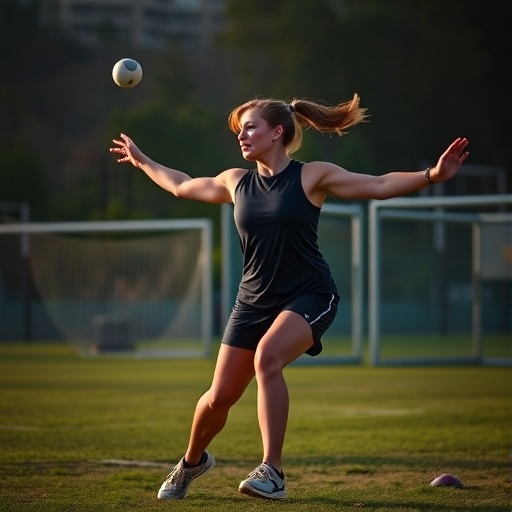In a world where gender norms shape our perceptions and behaviors, A. Fausto-Sterling’s latest research paper delves into the intricate relationship between gender and athletic performance, particularly focusing on the act of throwing. The critique presented in “Throwing like a girl: a critique of past approaches and an illustrated proposal for a path forward” uncovers the societal and biological underpinnings that have long perpetuated stereotypes about female athletes. Through a multi-faceted analysis, the paper advocates for a reevaluation of how society perceives gendered athletic skills and the implications of these perceptions.
The act of throwing, which we often take for granted, serves as a profound metaphor for the broader dynamics of gender equality in sports. Fausto-Sterling argues that the phrase “throwing like a girl” has historically been used to demean and belittle female athletes, suggesting an inherent inferiority in their abilities compared to their male counterparts. This stigma has not only shaped public perception but has also influenced the experiences of female athletes on and off the field. The research highlights the importance of changing the narrative surrounding such physical activities, advocating for a more nuanced understanding that recognizes the diversity of women’s athletic capabilities.
One of the critical components of Fausto-Sterling’s critique is the examination of past research methodologies that have treated sex and gender as binary categories. These approaches have often overlooked the rich spectrum of gender identities and expressions that exist beyond the traditional male-female dichotomy. By pointing out these limitations, the paper sets the stage for a more inclusive and accurate representation of athletic performance that genuinely considers the complexity of gender. This shift not only enhances the field of sports science but also contributes to a broader societal understanding of athleticism as a human quality, rather than one confined to gender specifications.
Interestingly, Fausto-Sterling employs a combination of theoretical discourse and illustrative examples to convey her findings. The paper is replete with diagrams and visual representations that illustrate key concepts, aiding in the reader’s comprehension of the nuanced arguments presented. This visually engaging approach not only enhances readability but also underscores the importance of visualization in academic discourse—a space often dominated by dense text. The integration of illustrations facilitates a more dynamic interaction with the material, making it accessible to a broader audience that extends beyond academia.
Moving beyond critique, the paper proposes a pathway forward rooted in intersectionality. By considering multiple factors including race, class, and sexuality alongside gender, Fausto-Sterling argues that a more holistic understanding of what it means to “throw like a girl” can emerge. This concept encompasses the diversity of experiences within female athletics, challenging the one-dimensional views that have historically prevailed. Through this lens, the paper not only addresses issues of representation but also highlights the systemic barriers that female athletes face, leading to a more comprehensive discussion on how sports can evolve to be genuinely inclusive.
In addressing the physiological aspects of throwing, Fausto-Sterling emphasizes that differences in body mechanics should not be oversimplified to fit gender stereotypes. Scientific studies have shown that throwing techniques, body strength, and coordination can vary widely among individuals. The implications of these findings push back against the narrative that women are inherently less capable of performing physically demanding tasks. Instead of suggesting that women throw poorly due to biological inferiority, the research calls for an appreciation of the varied skill sets each athlete brings to the sport, redefining success in terms of individual ability rather than gendered expectations.
The call to action extends into the realm of education and training for female athletes. Fausto-Sterling emphasizes the need for coaches and trainers to recognize and nurture the unique talents of their athletes, free from the confines of gender stereotypes. Strategies that empower female athletes to embrace their capabilities can lead to enhanced performance and greater self-esteem, contributing to the evolution of women’s sports overall. Education systems, from schools to professional training facilities, hold a critical role in reshaping the narratives that influence young athletes today.
Moreover, the paper addresses the role of media representation in influencing societal attitudes toward female athletes. Historically, sports media has often sidelined women’s achievements, focusing instead on their appearances or personal lives rather than their athletic skills. By advocating for more equitable media coverage that highlights women’s sports in a positive light, Fausto-Sterling underscores the importance of media in shaping public perceptions and attitudes. A more balanced portrayal can inspire young female athletes and normalize the idea that they, too, can excel in sports traditionally dominated by men.
Ultimately, “Throwing like a girl” serves as a crucial reminder of the power of language and imagery in the realm of sports. The paper delineates the need for a conscientious critique of how dialogue around gender and athleticism can either perpetuate stereotypes or pave the way for equality. Fausto-Sterling’s work champions a future where athletes are celebrated for their individual skills rather than their adherence to outdated gender norms, fostering an environment where everyone can thrive.
As this research pushes the boundaries of how we understand gender and athletic performance, it also reflects a growing movement within the sports community to advocate for equity. Engaging in this dialogue is not simply about rethinking how we describe physical abilities; it is also about building an inclusive framework that champions diverse experiences and identities within the world of sports. The impact of Fausto-Sterling’s insights is likely to reverberate far beyond the confines of academic literature, influencing athletic culture, policy, and education for generations to come.
The publication of this research aligns with a broader cultural shift that seeks to dismantle patriarchal structures and empower marginalized groups. By advocating for a new approach to understanding athleticism that celebrates the varied experiences of all athletes, Fausto-Sterling contributes valuable insight into the ongoing conversation about gender, sport, and equality. As society continues to confront and address these issues, the ideas presented in this paper may well serve as a foundation for future innovations in how we view and support athletes of all backgrounds.
In conclusion, Fausto-Sterling’s research is not merely an academic exercise; it is a timely intervention in the ongoing discourse surrounding gender and athletics. By critically engaging with stereotypes, advocating for inclusivity, and promoting a more nuanced understanding of performance, this work challenges us to rethink our assumptions and embrace the diversity of athletic expression. The next time we witness an act of throwing—whether by a girl or a boy—let it serve as a reminder of the progress we can make when we reject harmful stereotypes and celebrate the full spectrum of human potential.
Subject of Research: The intersection of gender and athletic performance, focusing on perceptions of female athletes and societal stereotypes related to abilities.
Article Title: Throwing like a girl: a critique of past approaches and an illustrated proposal for a path forward.
Article References:
Fausto-Sterling, A. Throwing like a girl: a critique of past approaches and an illustrated proposal for a path forward.
Biol Sex Differ 16, 77 (2025). https://doi.org/10.1186/s13293-025-00759-8
Image Credits: AI Generated
DOI: https://doi.org/10.1186/s13293-025-00759-8
Keywords: Gender stereotypes, athletic performance, female athletes, media representation, inclusivity in sports, intersectionality.
Tags: A. Fausto-Sterling researchchallenges faced by female athleteschanging perceptions of female performancecritique of female athletesfuture solutions for gender equity in sportsgender and athletic performancegender equality in athleticsimplications of gendered athletic skillsreevaluating women’s sports narrativessocietal perceptions of gender in sportsstereotypes in female sportsthrowing as a gender metaphor





